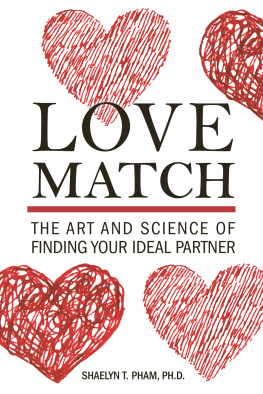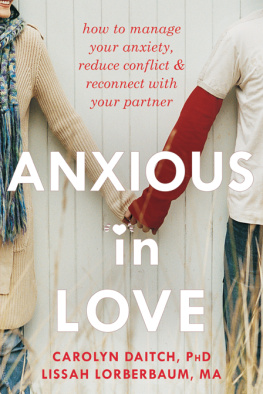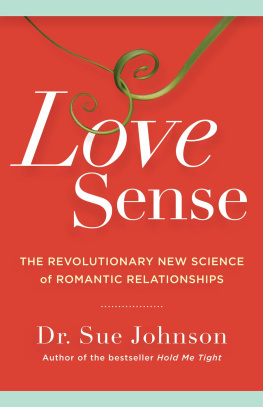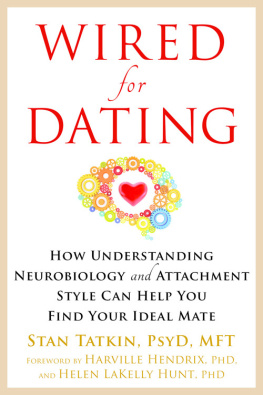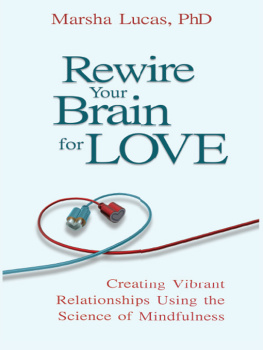
Stan Tatkin, PsyD , is assistant clinical professor in the family medicine department at the University of California, Los Angeles and is on the adjunct faculty of the masters psychology program at Antioch University in Santa Barbara, the masters psychology program at the California Lutheran University of Thousand Oaks, and the doctoral pre- and perinatal psychology program at Santa Barbara Graduate Institute. He teaches and supervises family medicine residents at Kaiser Permanente in Woodland Hills and is the creator of the psychobiological approach to couple therapy, or PACT. He is coauthor of Love and War in Intimate Relationships. He lives with his wife and daughter in Calabasas, CA.
Foreword writer Harville Hendrix, PhD , is a clinical pastoral counselor and cocreator of imago relationship therapy. He has more than thirty-five years of experience as an educator, public lecturer, and couples therapist. He is author of numerous books, including Getting the Love You Want.
This book is grounded in the latest brain science, as well as being wonderfully friendly, encouraging, and practical. It shows readers how to stay out of dead-end conflicts and instead light up the neural circuits of empathy, skillful communication, and love. A marvelous resource.
Rick Hanson, PhD, author of Buddha's Brain
I really enjoyed this book and learned a lot from it that I can use as a therapist. Stan Tatkin is a great innovator. This book is a must for every couples therapists library.
John Gottman, author of The Science of Trust
If you feel lost, confused or alone in your relationship, get this book right now. You will finally make sense out of chaos and pain. This is your map to go from frustration and insecurity to realize the potential of why you initially got together. Stan Tatkins insightful book will teach you to work as a team to make your relationship journey safe, engaging, and deeply satisfying.
Peter Pearson, PhD, couples therapy specialist and cofounder of The Couples Institute in Menlo Park, CA
Stan Tatkin shows how our couple relationships would look if we took seriously what attachment theory and neuroscience research has taught us.
Dan Wile, author of After the Honeymoon
Wired for Love challenges partners to experience their relationship in a totally new way. Partners will learn how to engage positively as a couple to help each other feel safe and secure by following the relationship exercises suggested in this exciting new book. In clear, concise language, Tatkin describes the ways that partners can understand and become experts on one another. He suggests building a couple bubble wherein each partner is the most important person in the others life, the one individual on whom the partner can always count.
Marion F. Solomon, director of clinical training at Lifespan Learning Institute and author of Narcissism and Intimacy, Lean on Me, and other books
Read this book to discover a multitude of new ways to enliven your relationship and end needless conflicts. Stan Tatkin is one of the most innovative thinkers in the couples relationship world today. It's impossible to read this book without learning new patterns to enhance your love.
Ellyn Bader, PhD, cocreator of the developmental model of couples therapy, codirector of The Couples Institute in Menlo Park, CA, and author of Tell Me No Lies and In Quest of the Mythical Mate
Reading Stan Tatkins book makes you want to be in therapy with him. With intense and fearless clarity, he takes you into the trenches of the combative human brain and shows you how to make love, not war.
Esther Perel, LMFT, author of Mating in Captivity

Publishers Note
This publication is designed to provide accurate and authoritative information in regard to the subject matter covered. It is sold with the understanding that the publisher is not engaged in rendering psychological, financial, legal, or other professional services. If expert assistance or counseling is needed, the services of a competent professional should be sought.
Distributed in Canada by Raincoast Books
Copyright 2011 by Stan Tatkin
New Harbinger Publications, Inc.
5674 Shattuck Avenue
Oakland, CA 94609
www.newharbinger.com
Cover design by Amy Shoup; Text design by Tracy Marie Carlson; Acquired by Tesilya Hanauer; Edited by Clancy Drake
All Rights Reserved
epub ISBN: 9781608826407
Library of Congress has cataloged the print edition as:
Tatkin, Stan.
Wired for love : how understanding your partners brain and attachment style can help you defuse conflict and build a secure relationship / Stan Tatkin.
p. cm.
Includes bibliographical references.
ISBN 978-1-60882-058-0 (pbk.) -- ISBN 978-1-60882-059-7 (pdf e-book)
1. Intimacy (Psychology) 2. Interpersonal relations--Psychological aspects. 3. Cognitive psychology. I. Title.
BF575.I5T38 2012
158.24--dc23
2011028010
To my wife, Tracey, and daughter, Joanna, who keep me going and loving life.
Contents
Acknowledgments
First I must acknowledge my editor and dear friend, Jude Berman, who has kept me going and writing when my own avoidance and island nature take over. Without her guidance and gentle pressure, this book would certainly not have come to be. I have many mentors in my life to whom I am indebted: Allan Schore, Marion Solomon, Stephen Porges, Pat Ogden, Harville Hendrix, Ellyn Bader, John Bradshaw, and John Gottman, to name just a few.
Foreword by Harville Hendrix
Couplehood has been, from the dawn of human history, the primary social structure of our species, giving rise to larger structures of family, community, society, culture, and civilization. But interest in helping couples improve the quality of their relationships is a very recent phenomenon. What help couples got in the past came from their families or social institutions, primarily religious ones. But given that what happens in the home determines what happens in society, and given the perennial presence of conflict and violence between partners and among groups and cultures, we can conclude that that help was not very helpful. If we operate from the logical premise that healthy couples are essential to a healthy society, and vice versa, then helping couples should be elevated from a romantic sentimentand a professional careerto a primary social value. The best thing a society can do for itself is to promote and support healthy couples, and the best thing partners can do for themselves, for their children, and for society is to have a healthy relationship! This book points in that direction, describing and giving concrete guidance toward a view of intimate partnership that can help couples shift their focus from personally centered needs to the needs of their relationship and, by extension, to the transformation of society.
This radical positionthat by transforming couplehood we transform every social structurehas been in the making only in the last twenty-five years or so. I want to briefly trace the emergence of couplehoodand of the evolving notions of help for couplesso that couples who read this splendid book can have a sense of their place in the history of this primary relationship. I want to also put Wired for Love in context.
We have little information about how prehistoric couples chose each other and how they related to each other, but the informed imagination of cultural anthropologist Helen Fisher offers us some clues that prior to 11,000 years ago, couples formed a pair bond for the purposes of procreation and physical survival. She believes this bond was based on an implicit ethic of sharing that served mutual interests and needs. Their roles were specific. Women gathered wood for the fires, cared for the children, and gathered fruit, berries, nuts, and roots, which they shared with the men. Men hunted wild game, which they shared with the women and children, whom they also protected from other men and wild animals. While these pair relationships were clearly sexual, they were not very durable and it is probable that they were not very intimate. Estimates are that they lasted about three years on average, or until the children were mobile. Both sexes repeatedly sought and consummated other relationships. Women gave birth to many children from different fathers and men sired many children with whom they most likely spent little time and whom they seldom recognized as their progeny. Most children were reared by single mothers and transient fathers.





